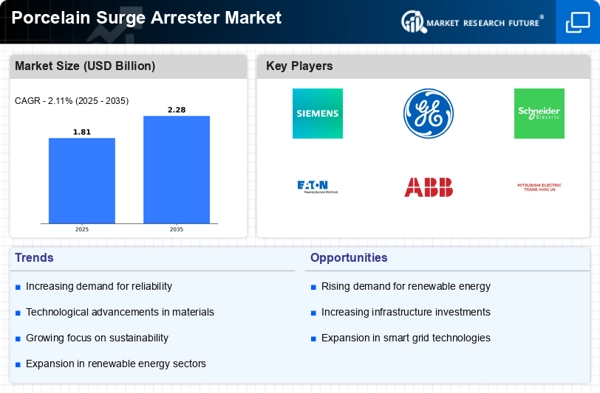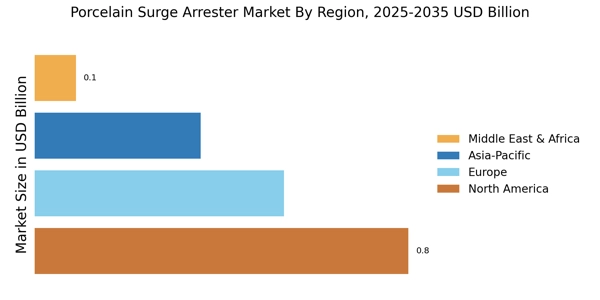Government Initiatives and Funding
Government initiatives and funding aimed at enhancing electrical infrastructure are playing a pivotal role in the Porcelain Surge Arrester Market. Various governments are implementing policies to support the modernization of electrical grids and promote the use of advanced surge protection technologies. Funding programs and incentives for renewable energy projects often include provisions for surge protection equipment, thereby boosting market demand. Recent reports indicate that government investments in energy infrastructure are projected to increase significantly, creating a favorable environment for the Porcelain Surge Arrester Market. This trend suggests a sustained growth potential as public sector support continues to drive advancements in surge protection solutions.
Rising Awareness of Electrical Safety
Rising awareness of electrical safety among consumers and industries is a significant driver for the Porcelain Surge Arrester Market. As electrical systems become more complex, the potential risks associated with voltage surges are increasingly recognized. Educational campaigns and regulatory initiatives are promoting the importance of surge protection in preventing equipment damage and ensuring safety. This heightened awareness is leading to increased adoption of porcelain surge arresters across various sectors, including residential, commercial, and industrial. Market data suggests that the demand for surge protection devices is likely to grow as safety standards become more stringent, thereby enhancing the Porcelain Surge Arrester Market.
Increasing Demand for Renewable Energy
The Porcelain Surge Arrester Market is experiencing a notable surge in demand due to the increasing investments in renewable energy sources. As countries strive to transition towards sustainable energy, the integration of wind and solar power systems necessitates robust surge protection solutions. Porcelain surge arresters are essential in safeguarding electrical systems from voltage spikes, which are common in renewable energy installations. The market for renewable energy is projected to grow significantly, with investments expected to reach trillions of dollars in the coming years. This growth directly correlates with the rising need for reliable surge protection, thereby driving the Porcelain Surge Arrester Market forward.
Expansion of Electrical Grid Infrastructure
The expansion of electrical grid infrastructure is a critical driver for the Porcelain Surge Arrester Market. As urbanization accelerates, the demand for a more resilient and efficient electrical grid becomes paramount. Governments and utility companies are investing heavily in modernizing existing infrastructure to accommodate growing energy needs. This modernization often includes the installation of porcelain surge arresters to protect against transient overvoltages. According to recent data, investments in grid infrastructure are expected to exceed hundreds of billions of dollars over the next decade. This trend indicates a robust growth trajectory for the Porcelain Surge Arrester Market as utilities seek to enhance grid reliability and safety.
Technological Innovations in Surge Protection
Technological innovations in surge protection are significantly influencing the Porcelain Surge Arrester Market. Advances in materials science and engineering have led to the development of more efficient and durable porcelain surge arresters. These innovations not only improve performance but also extend the lifespan of surge protection devices. The market is witnessing a shift towards smart surge arresters that can provide real-time monitoring and diagnostics. This trend is likely to attract investments from various sectors, including telecommunications and industrial applications, further propelling the Porcelain Surge Arrester Market. As technology continues to evolve, the demand for advanced surge protection solutions is expected to rise.


















Leave a Comment